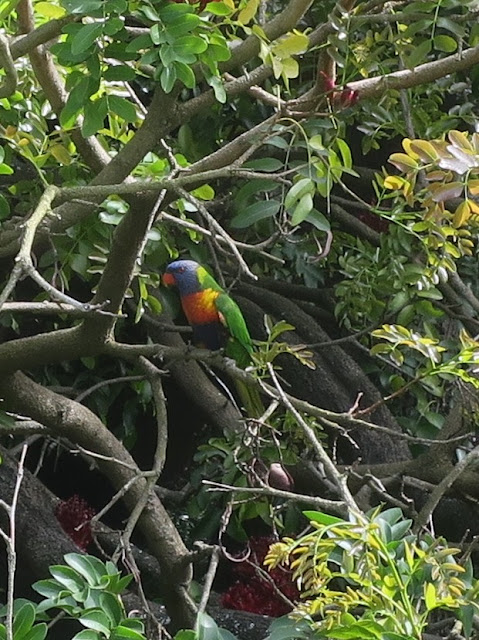Following on from last week's posting, this time my Geelong students ended term four of 2021 with an "ikebana at home" exercise. The class members met at the home of my student Tess. They had been asked to bring materials for an ikebana and were asked to include red and/or white flowers. Each student was allocated a location to make their ikebana by drawing a number from a hat, which indicated one of the eight designated locations. After considering the locations and the materials the student had brought, they then selected a vase they had never used before from Tess's collection.
Maree's ikebana was located on a chest of drawers in a bedroom. She had prepared some white paper lanterns which she wrapped around a stem of tortuous willow. A single stem of white gladiolus stood at the back of the willow and two red carnations created colour focal points low in the arrangement.
Jo arranged her ikebana on a shelf, also in one of the bed- rooms. This freestyle ikebana is very close to a "Slanting Variation Number Three, nageire style". The materials from her garden are Japanese maple and a very long stemmed red Geranium.
On a side-table in the entrance hall, Christine arranged a silver-sprayed Palm inflorescence. To this she added some red succulent flowers, red-sprayed dried leaves and green glass baubles.
Tess used one black and one white ceramic bottle of the same shape. In them she arranged some red flowering Melaleuca branches and added two small white Snapdragon flowers at the neck of the black bottle.
On a side-table in the same room Maureen arranged some cascading stems of Agonis flexuosa, from which she stripped all the leaves to show the lines. Red Alstromeria flowers make a focal point at the base of the stems.
On a small side-table in the living room Helen M created a slanting arrangement using pine and two, red pincushion Leucospermum,
In responding to the red and silvery-grey Japanese print of two fish, Ellie chose this black triangular vase for her ikebana...
... Her materials are pine needles and small white chrysanthemums. She added the silver-painted structure made from bamboo skewers to reflect the lines of the calligraphy.
Helen Q made this table-centre ikebana using blue Spruce with a focal cluster of silver baubles. The tall glass vase has grey vertical lines.
After discussing each of the ikebana, we all shared a relaxed evening meal.
* * * * *
Over the last week the New South Wales Branch of the Sogetsu School has held an exhibition in the Calyx at the Royal Botanic Gardens Sydney. The live exhibition was supplemented by an online exhibition to which Sogetsu members were invited to participate. The theme of the exhibition was Sogetsu Awakening, to reflect the experience of coming out of the many, lengthy Covid lockdowns endured in Australia and around the world. This link is to the Online Exhibition.
Here is my ikebana for the exhibition. Using three Banksia flowers, I have tried to express a sense of the materials arising from within the vessel and their movement as they stretch, writhe and move toward each other. The black-lacquered vessel is by Hiroyasu Takizawa.Greetings from Christopher
9.05 pm. (running late) 12th December 2021

























